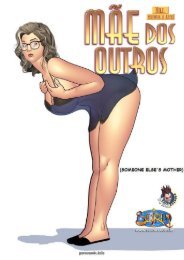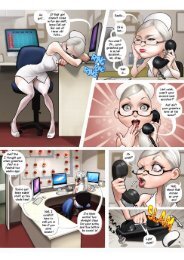AmericanCinematographer201201
Create successful ePaper yourself
Turn your PDF publications into a flip-book with our unique Google optimized e-Paper software.
•|• New IIF-ACES Workflow in Action •|•
Last year the FX series
Justified became the
first episodic TV show to
test the Academy’s IIF-
ACES workflow, which it
did using Sony cameras,
and since then post facility
Encore has begun using
the process on shows that
use different capture
media, among them
35mm film, the Arri Alexa
and the Red Epic.
Encore senior colorist Pankaj
Bajpai reports that IIF-ACES is being
used to color correct/finish Hung and
Enlightened, which are shot on 35mm;
Chicago Code and How to Make it in
America, which are shot with the Alexa
(using SxS cards to record to the ProRes
4:4:4 codec); and the new season of
Justified, which is shot on Red’s Epic.
“The image characteristics yielded by all
these different digital sensors are unique
to each camera, just as the image characteristics
of the various film negatives
are unique, but once you have the proper
input-device transform for each camera,
the reference-rendering transforms and
output-device transforms remain the
same within the IIF system, regardless
of the camera used,” explains Bajpai.
“Is there a difference between the
look of Epic images and Sony F35
images? Absolutely, ” he continues. “Is
one better than the other? That’s an
aesthetic question. However, in terms of
supporting the full range of what each
sensor or film stock can capture, IIF-
ACES has proven to be very simple to
work with. It brings all of that information
into a common workspace. With
the color correction, our job is to respect
the uniqueness of these cameras and the
cinematographers’ intentions for shooting
with them.”
For the HBO series Hung, shot
by Uta Briesewitz, Encore scans 3-perf
Super 35mmnegative on a 4K Spirit
and saves the data as 1920x1080 10-bit
uncompressed DPX files. “We then use
Pankaj Bajpai
the IDT for film negative
that the Academy has
provided to bring that
material into ACES,” says
Bajpai. “It’s amazing how
well a 10-bit DPX scan
falls into place with it.
[Once in ACES space,] we
can color correct it using
the same RRTs and ODTs
as we would on a digitally
captured show.
“In the past,” he continues, “TV
shows would do a telecine transfer from
film to some form of video, such as
DigiBeta, D1 or HDCam, but you
could never really record the full range
of what was on the negative. Even in
HD, you were limited by the Rec 709
gamut. There were ways you could try to
flatten the image and retain more detail,
but there wasn’t anything like 10-bit
DPX uncompressed data.
“ACES really captures all of the
characteristic curves and the way that
film behaves, with very meaty midtones,
gorgeous blacks that don’t have
the sort of blue noise you sometimes get
with film scans, and creamy, subtle
highlights. On Hung, even with areas of
underexposure in dark scenes, we can
maintain detail while making the blacks
rich.”
The new season of Justified, shot
by Francis Kenny, ASC,is being
captured with Red’s Epic, which offers
5K Bayer-sensor resolution and framerate
versatility. (It allows up to 96 fps in
full-frame 5K.) For that show, says
Bajpai, “we’re working from the raw
.r3d files and have an IDT that’s
designed to maintain the integrity of the
native full dynamic range of those files.
Of course, at some point the .r3d files
have to be deBayered, and we are
deBayering them in such a way that our
color-science maps out. The ACES
workflow is working very well. We’re
getting very good blacks, lots of detail in
the highlights, and really meaty midtones.”
— Christopher Probst
◗ Go with the Flow
what was there in the original image. It’s
the ultimate way to future-proof your
‘digital negative.’”
To understand how IIF-ACES
works, it’s necessary to distinguish
between linear and log encoding. Linear
encoding is often confused with video
gamma, which is sometimes called
linear video. The linear encoding we are
discussing is scene linear, which represents
images that have a linear relationship
between the captured RGB values
and the physical light luminosities of
the original scene. Logarithmic encoding,
on the other hand, encodes images
with a non-linear relationship to the
scene’s physical light intensities,
mapping the scene’s dynamic-range
information within a smaller number of
bits. Its values, therefore, do not increase
in tandem with the physical light levels
present in the taking scene. It is important
to realize that although film densities
have a logarithmic relationship to
the scene, not all logarithmic encodings
encode the images as film would have.
Many of today’s popular digitalcinema
cameras utilize log encoding as
part of their recording schemes. Arri’s
Alexa can incorporate Log C encoding
with its ProRes recording option, and
Sony’s F35 and SRW9000PL employ
the company’s S-Log format. On the
linear side of the coin, several camera
systems offer raw linear data capture,
including Red’s One, Scarlet and Epic,
the Alexa (when using third-party
onboard recorders to capture ArriRaw
data) and Sony’s F65. In order to
capture the full capabilities of these
cameras, the IIF uses custom inputdevice
transforms, or IDTs, to ingest the
maximum information from the original
data into the ACES color space.
“Most of the IDTs are created by
looking at the spectral sensitivities of the
sensor on a given camera,” Clark
explains. “The Academy has analyzed
that data and very carefully devised a
matrix for each camera — assuming, of
course, that the camera manufacturer
allowed them to go that deep into their
specs. If not, then the onus is on the
manufacturer to provide the matrix that
Photo courtesy of Encore.
84 January 2012 American Cinematographer













